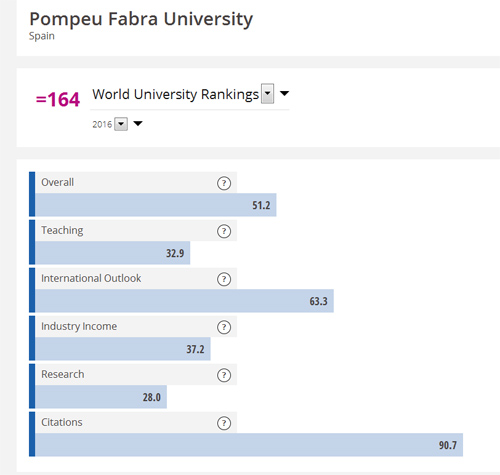UPF remains among the top 170 universities in the world, according to the Times Higher Education ranking for 2015-2016
UPF remains among the top 170 universities in the world, according to the Times Higher Education ranking for 2015-2016

Times Higher Education (THE) has just presented the 2015-2016 edition of the World University Rankings, one of the most prestigious and most internationally acclaimed. In this edition, UPF has risen one place with respect to last year (from 165th to 164th), and ranks as the second Spanish University in the list and 79th in Europe.
This annual ranking (now in its twelfth edition and extended to 800 institutions) is drawn from a combination of 13 indicators corresponding to five major areas, weighted as follows: Teaching (30%), Research (30%), Internationalization (7.5%), Transfer (2.5%) and Citations (30%).
UPF improves in most indicators
Compared to the scores UPF obtained last year in each of these indicators, it has improved in four of the five items (except Research, falling slightly), as well as the overall score, which increases from 48.1 to 51.2.
The most noteworthy indicators are Teaching, increasing from 25.1 to 32.9; Citations (which measures the impact of publications, and therefore, the influence of the research of each institution), which has gone from 83.3 to 90.7 and is, by far, the University’s most outstanding indicator. The Internationalization indicator remains high, above 63.
Continued Anglo-Saxon domination
The 2015-2016 edition of the THE ranking shows, once again, the dominance of the Anglo-Saxon universities. The top ten positions are held by the following universities: California Institute of Technology, Oxford, Stanford, Cambridge, MIT, Harvard, Princeton, Imperial College London, ETH Zurich-Swiss Federal Institute of Technology Zurich and University of Chicago.
A total of 25 Spanish universities appear in the ranking. Among the top two hundred institutions we can find the Autonomous University of Barcelona, in 146th; UPF (164th) and the University of Barcelona (174th). In the 301 to 350 bracket are the Autonomous University of Madrid and the University of Navarra, while the Complutense University of Madrid, the Polytechnic of Catalonia, Rovira i Virgili and Valencia are between 401 and 500.
Different orientations of the prestigious rankings
The ranking of THE, like the Quacquarelli Symonds (QS), although they consider teaching, focus on research and on the reputation of the institutions. There are some clearly research-oriented rankings (Leiden or Scimago); the Academic Ranking of World Universities (better known as the Shanghai ranking), gives great importance to indicators such as the number of former students who have a Nobel Prize.
Others look to move away from the closed rankings of universities and prioritize the user drawing up their own list, on the basis of the indicators they choose (this is the case of the U-Multirank promoted by the European Union; or the U-ranking, its Spanish counterpart promoted by the IVIE and the BBVA Foundation). Within the Spanish State, there are also notable initiatives such as the ranking of the CyD Foundation.
Other related e-news:
> UPF remains the only Spanish University among the Top 200 of the Times Higher Education ranking
Related Assets
La depressió té dues cares, una genètica i l'altra ambiental
Revela un estudi fet en bessons monozigòtics publicat a Human Brain Mapping codirigit per Gustavo Deco, ICREA del Departament de Tecnologies de la Informació i les Comunicacions i director del Centre de Cognició i Cervell.
Troballes recents indiquen que alteracions en la connectivitat de l'amígdala en estat de repòs cerebral mesurades per ressonància magnètica funcional fMRI (tècnica d’imatge que mesura l’activitat del cervell segons el consum d’oxigen) juguen un paper important en l’etiologia de la depressió.
 La contribució relativa de factors genètics i ambientals a la malaltia està encara en estudi. Per tècniques de neuroimatge s’ha posat de manifest que hi ha patrons matemàtics de l’estat de repòs d’aquesta àrea cerebral l’alteració dels quals pot discriminar entre un cervell malalt i un cervell sa.
La contribució relativa de factors genètics i ambientals a la malaltia està encara en estudi. Per tècniques de neuroimatge s’ha posat de manifest que hi ha patrons matemàtics de l’estat de repòs d’aquesta àrea cerebral l’alteració dels quals pot discriminar entre un cervell malalt i un cervell sa.
La recerca publicada a la revista Human Brain Mapping que ha estat codirigida per Gustavo Deco, investigador ICREA del Departament de Tecnologies de la Informació i les Comunicacions (DTIC) i director del Centre de Cognició i Cervell amb Lourdes Fañanás, investigadora de la Universitat de Barcelona (UB), ha estudiat la influència dels gens i el medi ambient en la connectivitat en estat de repòs de l’amígdala, mesurada per fMRI, en relació amb el risc de patir depressió.
Els bessons monozigòtics provenen d’un sol òvul que desprès de ser fecundat es divideix en dos parts iguals i tenen seqüències d’ADN gairebé idèntiques, per la qual cosa el treball s’ha centrat en l’estudi de les diferències i similituds en una mostra d’individus bessons per identificar les influències familiars i ambientals de la malaltia.
L’equip d’investigadors va analitzar els patrons de connectivitat de l’amígdala per ressonància magnètica funcional d’alta resolució d’una mostra de 48 persones bessones (24 parelles monozigòtiques). Es va recollir informació sobre la presència i absència de diagnòstic de depressió en les històries clíniques, i la mostra va quedar constituïda per sis parelles de bessons concordants, vuit no concordants i deu de sans, que van actuar com a controls.
Els investigadors van elaborar un marc teòric gràfic per construir xarxes cerebrals emprant dos aproximacions metodològiques diferents i els resultats van indicar que el risc de desenvolupar depressió s’incrementa per factors ambientals que alteren la connectivitat de l’amígdala, la qual cosa no treu que els factors genètics segueixen tenint una important contribució al risc de depressió. En definitiva, pel que fa al risc de patir depressió, els resultats de l’estudi mostren que tant els gens com el medi ambient modifiquen diferents patrons de la connectivitat de l’amígdala en estat de repòs cerebral.
Aquest estudi ha estat liderat per Gustavo Deco i Lourdes Fañanás, investigadora de la Unitat d’Antropologia del Departament de Biologia Animal de la Facultat de Biologia de la UB, i han comptat amb la col·laboració d’investigadors del Centre de Recerques Biomèdiques en Xarxa de Salut Mental (CIBERSAM) de Madrid, de l’IDIBAPS i del Centre de Diagnòstic per Imatge de l’Hospital Clínic de Barcelona, del Centre de Recerca en Xarxa en Bioenginyeria, Biomedicina i Nanomedicina (CIBER-BBN) de Saragossa i del Departament de Psiquiatria i Psicoteràpia de la Universitat de Jena (Alemanya).
Treball de referència:
Aldo Córdova-Palomera, Cristian Tornador, Carles Falcón, Nuria Bargalló, Igor Nenadic, Gustavo Deco i Lourdes Fañanás (2015), “Altered Amygdalar Resting-State Connectivity in Depression is Explained by Both Genes and Environment”, Human Brain Mapping , 36:3671-3776.
Crédits de la imatge:
https://www.flickr.com/photos/cristinagongora/8201295446



